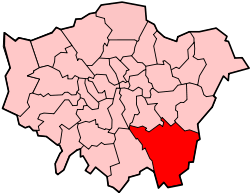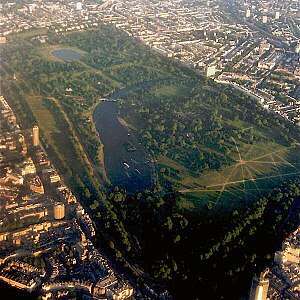Bromley Common
Bromley Common (grid reference TQ420670) is the area centered on the road of the same name, stretching between Masons Hill at the south end of Bromley and Hastings Road, Locksbottom. The area lies in the London Borough of Bromley and borders onto other suburbs such as Petts Wood and Orpington.
| Bromley Common | |
|---|---|
 | |
 Bromley Common Location within Greater London | |
| Population | 15,113 (2011 Census. Bromley Common and Keston Ward)[1] |
| OS grid reference | TQ416669 |
| London borough | |
| Ceremonial county | Greater London |
| Region | |
| Country | England |
| Sovereign state | United Kingdom |
| Post town | BROMLEY |
| Postcode district | BR2 |
| Dialling code | 020 |
| Police | Metropolitan |
| Fire | London |
| Ambulance | London |
| UK Parliament | |
| London Assembly | |
Amenities
%2C_Bromley%2C_Kent_-_geograph.org.uk_-_1115581.jpg)
Besides this well-used thoroughfare between Kent and central London, part of the A21, Chatterton Road has a number of popular restaurants, delicatessen, hair and beauty salons, the Chatterton Arms pub (the village and the pub were named after the 18th-century poet, Thomas Chatterton)[2] and a range of hobby/craft and charity shops. The pub, which opened around 1870, was originally named the "Hit or Miss", presumably a reference to "Shooting Common", dating back to the 'dark' days of highwaymen.[2]
The area has been awarded village status by the local authority and is known as Chatterton Village. Recent improvements include flower boxes, a village sign, Victorian-style lamp posts and a village notice board outside the bakery. The nearby Whitehall Recreation Ground has also been enhanced by the Friends of Whitehall Recreation Ground with help from Bromley Council's Parks Department with flower beds, seating, a picnic area, a wildlife pond and a refurbished children's play area (which was funded by the Friends of Whitehall Recreation Ground).
History
Until the 1860s, Bromley Common consisted mainly of farmland and the estates of a few large landowners. The common itself was owned by the Bishops of Rochester as Lords of the Manor, but on the condition that various ‘commoners’ should be allowed to freely enjoy their privileges on it. It amounted to about 300 acres, extending irregularly along the sides of the road that formed the main route from Tunbridge Wells and Hastings to Bromley and, beyond, to London. It was a well-known and profitable haunt for highwaymen. After the common was enclosed by Act of Parliament in 1826 (the Act was passed in 1821), there was some limited residential development, but this was mostly to the south of the old common, where it fanned out from the main road; a substantial number of homes had been built around Oakley Road and Princes Plain such that in 1842 Holy Trinity Church, at the junction of Bromley Common and Oakley Road, was built to cater for the expanding population. In the northern section of the old common development was much more modest, with just a few dozen homes put up along the east side of the road.[3]
At the heart of what is now Chatterton Village stood the grounds of Bromley Villa (later renamed Walpole Lodge), a large house owned by gentryman landowner Henry Hebbert. It was his death in 1864, and the subsequent auction of Bromley Villa, that presaged the residential development out of which Chatterton Road was built.[4] This first tranche of development to the east of Bromley Common stretched from Chantry Lane to Johnson Road, between which lay Pope Road and Walpole Road; connecting these roads and running parallel to Bromley Common was Chatterton Road. Only in the late 1870s did the area just to the north – including Bloomfield, Addison and Cowper roads – begin to be developed. The development to the south – of Mosslea, Balfour, Albert, Victoria and Salisbury roads and Crown Lane – began around the turn of the 20th century.[5]
Cricket venue
| Location | Bromley, Kent |
|---|---|
| Home club | Bromley Cricket Club |
| County club | Kent |
| Establishment | by 1735 |
The first definite mention of the Bromley area in a cricket connection is a 1735 match on Bromley Common between a Kent side and London Cricket Club.[6] The common was used for matches on at 12 occasions between 1735 and 1752, a period which coincided with Bromley Cricket Club having one of the strongest teams in England during the career of Robert Colchin. The last historic match known to have been played there was between Bromley and London on 30 June 1752.[7] Cricket has been played on the common in recent years.
Notable people
- Richmal Crompton, author of Just William lived at "The Glebe" in Cherry Orchard Road
- Major-General Charles W. Norman, British Army officer
References
- "Bromley Ward population 2011". Neighbourhood Statistics. Office for National Statistics. Retrieved 10 October 2016.
- Bromley Common News Archived 14 December 2011 at the Wayback Machine
- Bentley, Daniel. "The History of Chatterton Village, Bromley".
- Bentley, Daniel. "The History of Chatterton Village, Bromley".
- Bentley, Daniel. "The History of Chatterton Village, Bromley".
- H. T. Waghorn, Cricket Scores, Notes, etc. (1730-1773), Blackwood, 1899.
- G. B. Buckley, Fresh Light on 18th Century Cricket, Cotterell, 1935.

